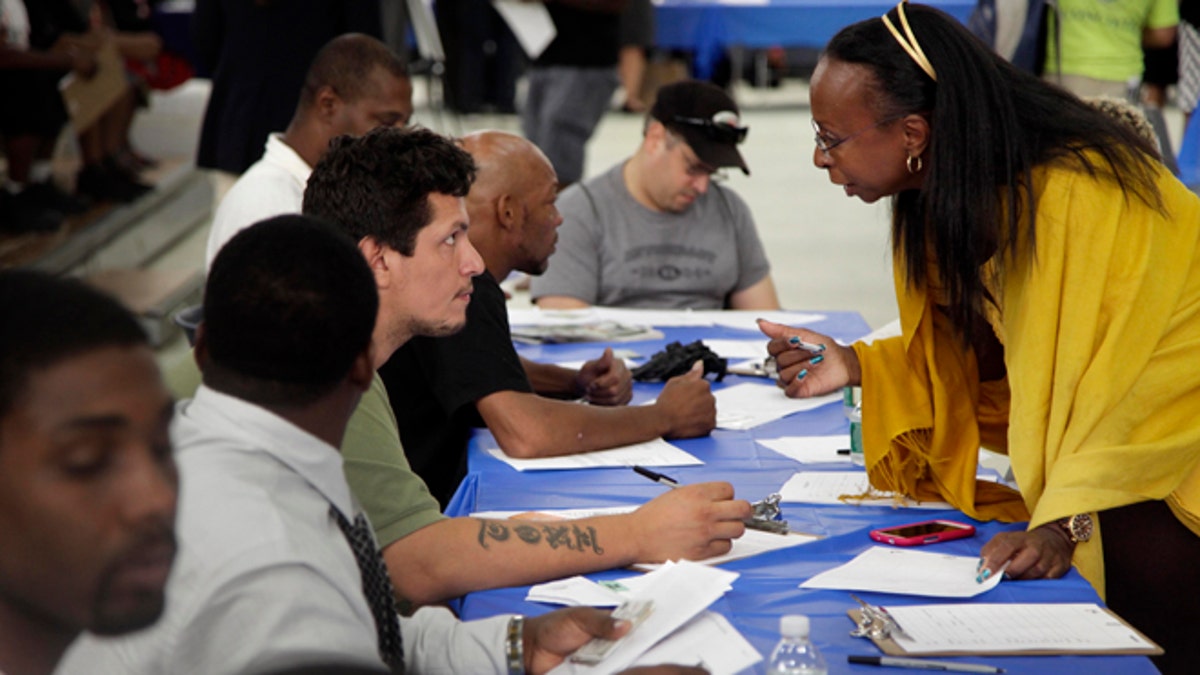
Aug. 21, 2012: Job seekers fill out applications at a construction job fair in New York. (AP)
One thing the current economic slump has made painfully clear is that the unemployment rate is an imperfect tool for gauging the health of the economy. Washington should replace it with a more meaningful and useful benchmark: the labor-force participation rate.
The widely publicized unemployment rate, eagerly awaited each month by pundits and policy wonks, has become little more than a shell game in which officials keep the public guessing about the real state of the economy.
Since October 2009, the main unemployment measure has dropped nearly two percentage points, from 10 percent to 8.1 percent, yet the economic outlook remains dismal.
Median family income has dropped about 8 percent since the start of 2009; the percentage of recent college graduates who can’t find work in their fields has skyrocketed, with some estimates as high as 60 percent; even the birthrate has declined, as young people struggle to get established.
Clearly, the unemployment rate is not telling the full story.
The labor force participation rate – which has fallen significantly, from 66.1 percent in 2008 to 63.5 percent today – tells us far more. That’s because it includes everybody of working age, even those who have left the work force. The unemployment rate excludes such individuals, presenting a rosier picture than exists.
The most commonly used unemployment measure, known as U-3, is the percentage of the workforce that is unemployed and actively seeking work. Using this measure, when people drop out of the labor force they statistically disappear. The U-3 unemployment rate now hovers just over 8 percent. If those who have given up and have stopped looking for work were included, the unemployment rate would exceed 11 percent. Even the broadest measure of unemployment, U-6, fails to include the long-term unemployed who have been out of the job market for a year or more.
The labor force participation rate, on the other hand, measures the percentage of the working-age population currently holding jobs or seeking work. Using this measure, when individuals stop looking for work, they don’t disappear; they remain in the working-age cohort.
Using the participation rate as the benchmark, therefore, would change policy makers’ incentives, since the only way to improve this measure would be to increase the percentage of people working or seeking work.
Indeed, the focus on the unemployment rate masks the ineffectiveness of government “jobs” policies. Politicians can lower the U-3 rate – and make things seem better than they are – by making it easier for people to leave the workforce.
And there are many such incentives. The number of people receiving Social Security disability benefits, for instance, has nearly tripled since 1993. And unemployment benefits were extended to nearly two years during the downturn.
Another government policy that has removed large numbers of people from the workforce is the push to increase college attendance – with loans, grants, and tax credits. In 1940, roughly 10 percent of the adult population had attended college; today, a majority of the adult population has.
While having an educated workforce is generally beneficial, some of what’s going on – at taxpayer expense – needs to be questioned. Many schools graduate a third or fewer of their students; frivolous degree programs abound; academic standards have been lowered. Government subsidies are driving these trends.
All this idleness hurts the economy, in good times and bad. We need to keep a reasonably high percentage of the population working to remain prosperous. In 1940 there were 159 workers for every Social Security recipient; today there are only 2.8 workers per recipient.
With too few workers to shoulder the heavy burden of government spending, our debt piles up, and the economy remains in low gear. If we stay on the current path, the economy will collapse under the weight of its social and educational programs.
Such grim reality demands a change of perspective.
Focusing on the labor force participation rate provides that change. If government officials are forced to respond to the declining percentage of working-age adults who are holding jobs or looking for work, rather than to the official unemployment rate, they will pursue policies that increase employment, rather than shrink participation.
That would be a good first step on the road to recovery.
Jay Schalin is director of state policy analysis at the John W. Pope Center for Higher Education Policy in Raleigh, NC.
